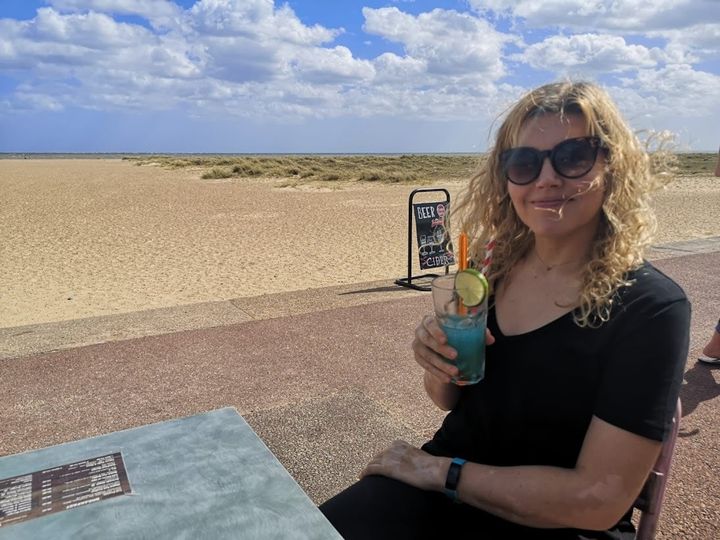
When my partner asked me if I’d seen the news, I went straight to my phone and found the BBC headline: “Vitiligo: Controversial skin cream may come to UK.” The article referenced the cream ruxolitinib, more commonly known by the brand name Opzelura. Touted by some as a “miracle cream,” it’s said to re-pigment skin and return it to its original color.
Vitiligo is an autoimmune disorder. Instead of attacking foreign bodies like viruses, the immune system targets its own healthy melanocyte cells ― those responsible for producing melanin. This shows up in the form of patches of white skin and white or gray hair. Segmental vitiligo affects just one area (a patch on the face, for example); universal vitiligo affects the entire body, though it’s very rare. I have the most common type, non-segmental vitiligo, where patches show up on both sides of the body.
A lot remains unknown about the condition. That became apparent after my referral to a skin specialist when I was 30, when the first white patches appeared. The dermatologist knew it was definitely vitiligo, but everything else seemed to be wrapped in “mights” and “maybes.” It might be caused by stress, skin damage, hormonal changes or chemical reactions. There are potential health complications, but the main risk is that your skin is now vulnerable, so sunburn is an absolute no-no. Vitiligo wasn’t life-threatening. The biggest threat was to my self-esteem.
Talk of treatment was even more ambiguous. Steroid creams could help to restore the pigment. Light therapy could help to slow it down or even stop it (but not reverse it)... so long as I could get to the hospital three times a week for the next six months. Oh, and it might increase my risk of skin cancer.
I opted to take vitamin D supplements and to improve my diet and fitness in the hopes that this might help. I did try the steroid cream, too, but I saw no change and eventually gave up.
Understandably, then, my initial reaction to hearing about Opzelura was cynical. But a scan of the article showed that the results did seem genuinely promising. In trials, 1 in 6 people who used the cream reported near complete re-pigmentation in three months. Half of the others showed significant improvement.
That’s groundbreaking. In a landscape of lengthy, often ineffective treatments, Opzelura is as close to a “cure” as many have hoped for. It’s already been approved in the U.S., where it’s selling for $2,000 a tube, and it looks set to follow suit in the U.K. and Europe for people ages 12 and above.
So why am I not more excited? Honestly, it’s complicated.
For one thing, Opzelura has the potential to weaken the immune system, leaving the patient open to more infections and colds. I also read that in trials, some patients developed redness or acne in the areas treated. And there are potentially far more serious side effects for people being treated for inflammatory infections.
But what I found scariest weren’t the side effects ― it was my own reaction. After nearly a decade of living with vitiligo, after working so hard to love and accept myself, I thought I was cool with my patches. Suddenly faced with my own inner wanting, I had to ask whether I really had accepted vitiligo. After all, hadn’t it been my only option? Without a treatment on the horizon, it was either self-acceptance or self-hatred.
When that first white mark appeared, it felt like a joke ― one that became crueler as it spread across my body. I’d wasted my youth collecting grievances in the mirror, obsessing over every bump and blemish. My sun-kissed glow was one of the few things I actually liked about myself. It seemed so unfair for my skin to turn on me after three long decades.
As a teacher, I’d had to practice being “seen” by students. A course of cognitive behavior therapy had helped me to manage crippling shyness and anxiety. By the time I was 30, I’d been practicing confidence for years. So it felt like a huge step backward to admit that what I hated most about my vitiligo was how eye-catching it was. It awakened the part of me that had opted to use the camouflage makeup all those years ago; the part that was desperate to hide, that longed to be “normal.”
When I was teaching, students would sometimes drift off and stare at my hands. And it wasn’t just kids ― it was their parents at parents’ evenings, shop assistants handing over receipts, friends and acquaintances whom I hadn’t seen in years. I used camouflage makeup (matched to my skin tone), on and off, for years, caking it on for “special occasions.” I did this until I realized it made me feel the absolute opposite of special.
As the braver students asked me about my skin, I became much more comfortable with talking about vitiligo. Older students mentioned Winnie Harlow, a successful model with vitiligo, and I felt proud to be included in such attractive company.
Even the comments that verged on unkind became teaching opportunities for both me and the other person. One boy said, with disgust, that if it happened to him, he wouldn’t go outside. But then he listened thoughtfully to his classmate’s argument. “Why should someone hide away and not live their life?” she asked. “Just because their skin looks different from those around them?”
I reflected on these words when I felt like hiding. I wanted my students to see me wear my vitiligo, embodying what I’d taught them about celebrating our differences.
A 5-year-old girl brought me a beautiful leaf from the playground: emerald green, with mottled patches of brownish-gold. She said it reminded her of my skin. I endeavored to see myself the way she saw me. Or, at least, to act like I did, until my thoughts caught up.
Over time, my efforts paid off. It became easier to see myself through that little girl’s lens. And that’s why Opzelura has left me conflicted. Admitting that I might like to “cure” my patches feels like a betrayal of that mindset.
I’m so grateful for the age we live in, where conditions like mine have become far more normalized. But reality is more nuanced. It seems wrong, even shameful, to admit that there are days when I do not feel blessed or grateful.
Beyond the emotional and mental challenges, having vitiligo can be pretty flipping irritating. For one, going outdoors takes a lot more preparation, requiring round-the-clock vigilance and supplies of high-test sunscreen to apply to any exposed skin. The patches can also be sore and sensitive. My largest “islands” are on my legs, and sometimes they itch like crazy.
Am I justifying myself now? Maybe, yes. The truth is, I still don’t really know how I’ll react if and when Opzelura is approved.
I’ve kept myself informed thanks to Reddit’s vitiligo community, reading reports from people who’ve tried Opzelura. There are stories of re-pigmentation, and (impressive) before-and-after pics. There are also people who report little to no change.
One man described having to stop treatment due to headaches and fatigue. For him, the side effects weren’t worth it. And I know I would feel the same. I won’t risk my health for the sake of something that only has minimal bearing on my life today.
I wouldn’t have been able to say this until recently. That, to me, is the measure of my progress. Through therapy, I’ve come to like and love myself, and to spot the difference between external and internal beliefs. My internal belief, the one that feels truest, is that self-acceptance and desire for change are not mutually exclusive. There’s space inside of me to be loving and accepting of my vitiligo, and also to feel excited about a potential treatment.
Confidence is often described as being “comfortable in your own skin.” But what I’ve learned is that it’s also about being comfortable in your choices. All that matters is that I choose what feels right for me.
Do you have a compelling personal story you’d like to see published on HuffPost? Find out what we’re looking for here and send us a pitch.
